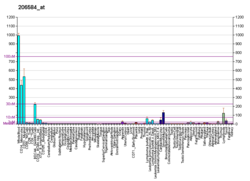Top Qs
Timeline
Chat
Perspective
Lymphocyte antigen 96
Protein-coding gene in the species Homo sapiens From Wikipedia, the free encyclopedia
Remove ads
Lymphocyte antigen 96, also known as "Myeloid Differentiation factor 2 (MD-2)," is a protein that in humans is encoded by the LY96 gene.[5][6][7][8]
The protein encoded by this gene is involved in binding lipopolysaccharide with Toll-Like Receptor (TLR4).
Remove ads
Function
The MD-2 protein appears to associate with toll-like receptor 4 on the cell surface and confers responsiveness to lipopolysaccharide (LPS), thus providing a link between the receptor and LPS signaling.[7] That is, the primary interface between TLR4 and MD-2 is formed before binding LPS and the dimerization interface is induced by binding LPS.[8]
Structure
MD-2 has a β-cup fold structure composed of two anti-parallel β sheets forming a large hydrophobic pocket for ligand binding.[9][10]
Interactions
Lymphocyte antigen 96 has been shown to interact with TLR 4.[5][11]
When LPS binds to a hydrophobic pocket in MD-2, it directly mediates dimerization of the two TLR4-MD-2 complexes. Thus, TLR4 and MD-2 form a heterodimer that recognizes a common pattern in structurally diverse LPS molecules. These interactions allow TLR4 to recognize LPS.[8] Macrophages in MD-2 knockout mice are unresponsive to LPS.[12]
LPS is extracted from the bacterial membrane and transferred to TLR4-MD-2 by two accessory proteins, LPS-binding protein and CD14, to induce innate immune response.[8]
References
Further reading
External links
Wikiwand - on
Seamless Wikipedia browsing. On steroids.
Remove ads






